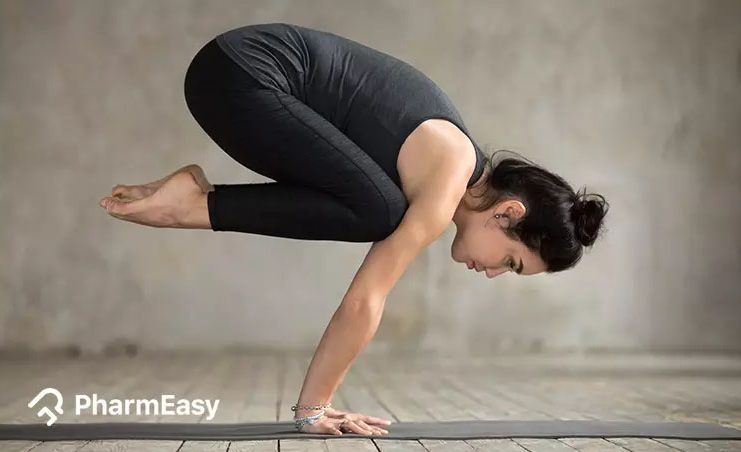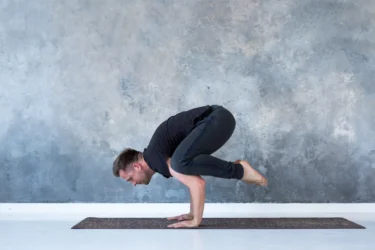Benefits of Bakasana (Crane Pose) and How to Do It By Dr. Ankit Sankhe
By Dr. Ankit Sankhe +2 more

Get,

to manage your symptom
Get your,


4 Cr+ families
benefitted

OTP sent to 9988776655



You’ve successfully subscribed to receive
doctor-approved tips on
Whatsapp

Get ready to feel your best.

Hi There,
Download the PharmEasy App now!!


Register to Avail the Offer
Send OTPBy continuing, you agree with our Privacy Policy and Terms and Conditions

Hi There,
Sign up on PharmEasy now!!
Trusted by 4 crore+ families

OTP sent to 9988776655



You have unlocked 25% off on medicines




Code: NU25
By Dr. Ankit Sankhe +2 more
Table of Contents
Health is wealth and all of us deserve the right to good health. Health is a positive concept that not only means freedom from diseases but also includes the feeling of well-being. Keeping this in mind, yoga has been introduced at the school level to teach healthy habits and a sustainable lifestyle from a young age1.
Yoga has its primary establishments in India. It is a form of science accepted worldwide, including the Western countries. Yoga aims at developing strength, endurance, and stamina at a physical level and empowers concentration and mindfulness at the mental level1.

Yoga teaches several asanas or postures. Here, we bring one such asana called Bakasana. Let’s read more about the Bakasana benefits, techniques, and much more.
Did You Know?
Bakasana comes from a Sanskrit word in which ‘Baka’ means ‘crane’ whereas ‘asana’ means pose or posture. The final position of this asana replicates a crane; hence, it is called the crane pose. Bakasana or the crane pose yoga, is an arm balancing pose as it exerts more pressure on the arms and wrist. Bakasana benefits may release negative emotions like stress, anxiety, and depression out of the body. It may create a sense of awareness in the body to maintain stability and focus1,3.
Bakasana variations may include Parsva Bakasana pose. In this asana, ‘Parsva’ means side and Bakasana means crane pose. Hence, also called the side crane pose. Parsva Bakasana yoga is classified as an intermediate level of yoga and it involves twisting and balancing on the arm. It is similar to the Bakasana pose as both arms are in front but unlike the crane pose, both legs are extended on one side3.
Bakasana is classified as an intermediate arm balance yoga pose. You may practice Padmasana (cross-legged sitting pose) as one of the Bakasana preparatory poses2,3. Bakasana steps are listed below:
Some of the potential benefits of the Bakasana are described below:

Stretching the body to become mobile and flexible might offer several physical benefits, such as improving body posture, reducing bodily pain and soreness, etc. Such flexibility exercises may allow deeper movements in the joints and muscles. Bakasana yoga might help you attain flexibility in your body. Combining crane pose with other flexibility exercises might reduce muscle stiffness. It might also increase the flexibility of the ankles, hips and knees2.
Are you an active sportsperson? Maintain your spine flexibility and core strength by practising yoga asanas. Yoga asana like Bakasana (crane position) aids in improving core muscle strength along with upper body strength. When practised with Ushtrasana, Bakasana might help in building spine flexibility, body strength, balance, and awareness5.
Dr. Siddharth Gupta, B.A.M.S, M.D (Ayu)

Depression may affect how you feel, think, and handle daily activities. Research has found that various environmental and psychological factors may lead to depression. The regular practice of Bakasana yoga might help overcome depression. In the Bakasana pose, you carry yourself above the ground, which might increase your blood pressure and boost your physical balance. Bakasana might be a suggestive solution for depression2.

Balance and coordination are the two main factors that help control body movement. Bakasana might help increase a sense of balance in the body, which might positively stimulate the functions of the nervous system. Bakasana yoga may also enhance concentration allowing you to focus more1,2.

Yoga practice may help develop the mind and body; however, it is not an alternative to modern medicine. Therefore, you should not rely on yoga alone to treat any condition. Instead, consult a qualified doctor who will be able to assess your situation correctly and advise accordingly. Furthermore, it is essential to practice yoga under the supervision of a professional trainer to avoid injuries.
Bakasana requires maintaining stability and hand-to-body coordination. Unfortunately, one wrong movement may lead to injury. While performing the Bakasana pose, watch out for the following risks:
With the guidance of a trained yoga master, you can assess and analyze the risk factors and continue to practice Bakasana with precautions.
Moving too fast while practising yoga asanas like Bakasana might lead to injury. As Bakasana focuses more on muscular strength and endurance, practise the yoga asana in a more gentle and controlled manner6.
Dr. Rajeev Singh, BAMS
Bakasana yoga is an intermediate-level arm-balancing yoga pose. Bakasana is also referred to as crane pose yoga. It might help attain flexibility of the legs, ankles, and hips. It might also increase the sense of balance in the body. As it is classified as an intermediate pose, it requires proper guidance from a trained Yoga teacher to be done without any complications.
Also Read: Benefits of Makarasana (Crocodile Pose) and How to Do it By Dr. Ankit Sankhe
Bakasana is an intermediate-level arm-balancing yoga pose. It combines two Sanskrit words: ‘Baka’ means ‘crane’ and ‘asana’ means pose. While performing the Bakasana pose, the final position appears as a crane; hence, it is called the crane pose1,3.
You may perform Bakasana yoga for five to ten seconds and if you are comfortable, you may hold the pose for one minute1,2.
Some of the contraindications of the Bakasana pose include knee pain, wrist pain, high blood pressure, heart disease, blood clots in the brain, pregnancy, and menstruation1,2.
The crane pose may target the arms, wrists, hips, shoulders, chest, and abdominal muscles.
Bakasana yoga is an intermediate pose and might be challenging to perform. Therefore, you should take precautions, such as avoiding excess pressure on the elbow while raising the feet and ensuring proper strength and stability while balancing the body1,2.
1. Uppal S, Sutar B. Yoga A Healthy Way of Living Secondary Stage. 1st ed. New Delhi: NCERT; 2015. 1–96 p. Available from: https://ncert.nic.in/dess/pdf/tiyhwlss1.pdf
2. Yogapoint- Guide to Yoga Practices. [Internet]. Yoga Point India; [cited 2022 Sep 6]. Available from: https://www.yogapoint.com/pdf/Yogapoint%20Book%20of%20Practices.pdf
3. Kaminoff L, Matthews A, Ellis S. Yoga Anatomy. United States of America: United Graphics; 2007. Available from: https://samadhiyogaashram.com/pdf/LeslieKaminoffYogaAnatomyzliborg-200817-225010.pdf
4. What is Bakasana? – Definition from Yogapedia [Internet]. [cited 2022 Oct 3]. Available from: https://www.yogapedia.com/definition/5192/bakasana
5. Singh N. Role of yoga in sports. Think India J. 2019;22(4):172-178 [cited 2025 Dec 19]. Available from: https://thinkindiaquarterly.org/index.php/think-india/article/view/10822/6531
6. Singh R, Singh V. Comparison of batting skills in terms of influence of intelligence of cricket players. In: UGC Sponsored 2nd National Conference on Latest Trends in Health and Physical Education, University College of Medical Sciences, University of Delhi, Dilshad Garden, Delhi; 2017 [cited 2025 Dec 19]. Available from: https://www.researchgate.net/profile/Vikram-Singh-21/publication/315572800_Comparison_Of_Batting_Skills_In_Terms_Of_Influence_Of_Intelligence_Of_Cricket_Players/links/592bf501a6fdcc44435cafc8/Comparison-Of-Batting-Skills-In-Terms-Of-Influence-Of-Intelligence-Of-Cricket-Players.pdf#page=24
Disclaimer: The information provided here is for educational/awareness purposes only and is not intended to be a substitute for medical treatment by a healthcare professional and should not be relied upon to diagnose or treat any medical condition. The reader should consult a registered medical practitioner to determine the appropriateness of the information and before consuming any medication. PharmEasy does not provide any guarantee or warranty (express or implied) regarding the accuracy, adequacy, completeness, legality, reliability or usefulness of the information; and disclaims any liability arising thereof.
Links and product recommendations in the information provided here are advertisements of third-party products available on the website. PharmEasy does not make any representation on the accuracy or suitability of such products/services. Advertisements do not influence the editorial decisions or content. The information in this blog is subject to change without notice. The authors and administrators reserve the right to modify, add, or remove content without notification. It is your responsibility to review this disclaimer regularly for any changes.
Comments

Leave your comment...
You may also like
Comments